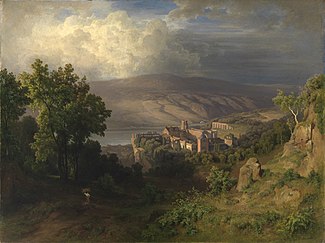

Bernhard Fries (16 May 1820, Heidelberg – 21 May 1879, Munich) was a German landscape painter and draftsman. He is associated with the Düsseldorf school of painting.
Biography[edit]
Bernhard Fries was one of fifteen children of the banker, dyer and art collector Christian Adam Fries [de] and his wife Luisa Christina née Heddaeus (1781–1858), daughter of the church administrator Philipp Christian Heddaeus. The family's prosperity allowed Bernhard to travel and work freely, without financial worries. The painter Ernst Fries (1801–1833) who was nineteen years his senior, was his brother. Bernhard was only thirteen when his brother died. In 1835, aged just fifteen, he received his artistic training from the history painter Carl Koopmann (1797–1894) in Karlsruhe, who had been a teacher of figurative drawing at the Karlsruhe Polytechnic since 1833. Also at an early age, Fries became aware of the Scottish painter George Augustus Wallis (his father's very valuable art collection comprised important Dutch painting of the period 1700–1800, paintings of Claude Lorrain, Poussin, Joseph Anton Koch, and several works by Wallis). Fries may also have met Wallis later in Italy on one of his travels.[1]
Around 1835, Bernhard met Carl Rottmann in Munich, who had been a closed friend of his older brother Ernst. In 1837, aged seventeen and without the knowledge of his parents, Fries went to Italy, first to Venice, in 1838 he arrived in Rome.[2] He traveled in France and Austria, and stayed for a few years (1838–1840 and 1843–1846) in Italy. He spent some time from 1840 to 1843 at the Academy in Düsseldorf. Amongst his most important works is the cycle of 40 Italian landscapes (now in Munich) that have been compared by some to the famous cycle by Carl Rottmann.[citation needed] Fries' Italian landscapes show careful composition and execution. After the completion of the series in 1866 he created the Italian views and Palermo Mamellen (in Schack Museum in Munich), Civitella, Garda, Rome, Naples, Palermo etc. as well as views of Heidelberg and motifs from the surrounding area. Fries died in Munich in 1879.
A rich collection of drawings and sketchbooks and some of the most important oil paintings showing southern Italian seaside landscapes between Rome and Naples as well as Palermo are in the private collection of a descendant. His paintings are represented in various museums, such as the great art galleries and museums in Darmstadt, Halle, Karlsruhe, Munich (Neue Pinakothek and Schackgalerie), Stuttgart and Zurich. The Palatinate Museum in Heidelberg has a comprehensive collection of works by Fries.
References[edit]
- ^ Galerie und Kunstantiquariat Joseph Fach; Winterberg – Kunst, Auktionen und Galerie (2017). Fries, Ernst; Fries, Bernhard; Fach, Bärbel; Fach, Martin; Winterberg, Thilo (eds.). Gebrüder Ernst und Bernhard Fries: Leben – Einordnung – Werk. Le Cabinet Japonais. Oberursel: Galerie Joseph Fach. p. 110. ISBN 978-3-932204-12-8.
- ^ Galerie und Kunstantiquariat Joseph Fach; Winterberg – Kunst, Auktionen und Galerie (2017). Fries, Ernst; Fries, Bernhard; Fach, Bärbel; Fach, Martin; Winterberg, Thilo (eds.). Gebrüder Ernst und Bernhard Fries: Leben – Einordnung – Werk. Le Cabinet Japonais. Oberursel: Galerie Joseph Fach. p. 111. ISBN 978-3-932204-12-8.
External links[edit]
![]() Media related to Bernhard Fries at Wikimedia Commons
Media related to Bernhard Fries at Wikimedia Commons